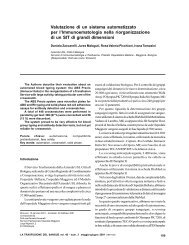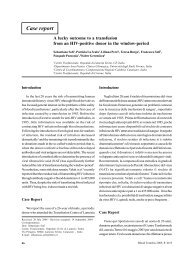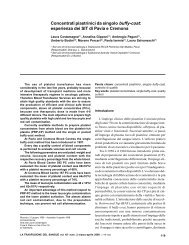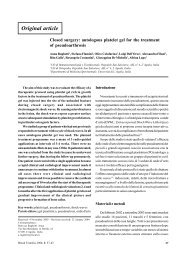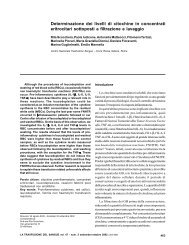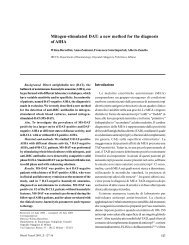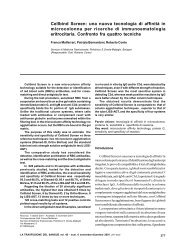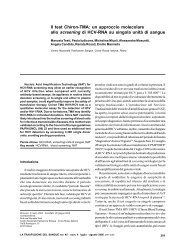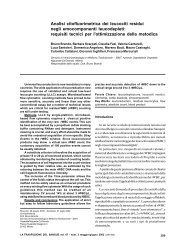Mathematics and transfusion medicine - Blood Transfusion
Mathematics and transfusion medicine - Blood Transfusion
Mathematics and transfusion medicine - Blood Transfusion
Create successful ePaper yourself
Turn your PDF publications into a flip-book with our unique Google optimized e-Paper software.
Bocciardo L et althat it is mainly the consumption of intravenous IgG thatdetermines the amount of plasma to be sent for industrialprocessing.Precisely because of its widespread clinical use, thegoal of meeting dem<strong>and</strong>s for intravenous IgG is difficult toachieve, since it would require an annual increase of about1,350 litres in the production of plasma, which is equivalentto about 84% of the current production. If such an aimwere to be reached, it would be of great financial importance,given that the cost of intravenous IgG is much higher thanthat of albumin. It should be remembered that the greaterproductive efficiency, achieved in 2005-2006, by thecompany that processes the plasma, with the current yieldof intravenous IgG being 3.1 g/L, could contribute to greateravailability of the product, without lowering the level ofpurity of the drug.As far as concerns antithrombin III, the problem of thelow theoretical coverage of requirements (23.94%) derivesfrom the fact that this drug is produced only from class Aplasma. At a regional level, this makes Liguria dependenton the production in other regions belonging to the AIP,which collect a larger number of donations with cellseparators.In order to contribute to self-sufficiency in plasmaderivatives, it is essential to implement regionally-basedstrategies <strong>and</strong>, in some circumstances, interregional ones.These strategies must take into account factors related tothe type of population of the donors, logistical aspects<strong>and</strong> agreements between the Associations that promotethe donation of blood. For this reason the role of the intra<strong>and</strong> extra-regional co-ordination, defined by law (LegislativeDecree. 219/05), is fundamental.ConclusionsThe analysis of the data collected leads to theconclusion that, although the production of plasma in thelast four years has increased <strong>and</strong> the consumption forclinical use has remained roughly stable, the volume ofplasma sent for industrial processing is insufficient to meetthe requirements for plasma derivatives: this is particularlyobvious for intravenous IgG, which are heavily requested.The quantification of this lack of coverage enabled usto plan procedures to reduce the shortfalls: the strategiesdecided were to further increase the production of plasma<strong>and</strong> in particular the volume of plasma collected using acell separator, <strong>and</strong> to optimise the clinical use of plasma<strong>and</strong> plasma derivatives.Our analysis also led us to conclude that theoptimisation of plasma production will never be sufficientto cover the notable increase in the consumption ofintravenous IgG in our Institute: it is, therefore, extremelyimportant to evaluate whether the increased requests aredue to an increase or improvement in health care servicesdelivered, or whether they are due to inappropriateconsumption of these plasma derivatives. In the light ofthe most authoritative international recommendations,collaboration with clinicians is essential in order to optimisethe use of plasma products <strong>and</strong> must have the concreteoutcome of the production of guidelines <strong>and</strong> the control ofthe appropriateness of the requests 2 .In fact, the good use of plasma derivatives, achievedby following appropriate guidelines, has obviousimplications for the safety of <strong>transfusion</strong>s, but also hasclear financial consequences 7 .The SIMT of the Gaslini Institute, thanks to itsrationalisation of plasma production <strong>and</strong> optimisation ofthe consumption of plasma derivatives <strong>and</strong> plasma forclinical use, is participating actively in the attempt to reachregional self-sufficiency. Nevertheless, the CRCC isessential in order to evaluate the various realties in theregional context.References1) Delibera Giunta Regionale del Veneto n.3305, 15 September 1998.2) Darabi K, Abdel-Wahab O, Dzik WH. Current usage ofintravenous immune globulin <strong>and</strong> the rationale behind it: theMassachusetts General Hospital data <strong>and</strong> a review of theliterature. <strong>Transfusion</strong> 2006; 46: 741-53.3) Zucchelli P. I consorzi in convenzione con l'industria per lalavorazione del plasma. Convegno Interregionale dei ServiziTrasfusionali del Nord. Vol. Abstract. 2005; 96.4) Sala ML, Isacchini E, Busi E, et al. Autosufficienza di plasmae plasmaderivati in Regione Lombardia. La Trasf del Sangue2001; 46:130-6.5) Rossi D. Raccolta di plasma e consumo di plasmaderivati. IlServizio Trasfusionale 2004; 3: 32-3.6) Catalano L, Orl<strong>and</strong>o M. Indagine conoscitiva sul consumo diplasmaderivati nelle regioni italiane: anno 1994. La Trasfusdel Sangue 1997; 4: 189-94.7) Gessi AM, Fabbri M, Farinato MA, Di Gregorio P. Usoimproprio di plasma fresco congelato ed emoderivati:incidenza sui DRG. Convegno Interregionale dei ServiziTrasfusionali del Nord. Vol. Abstract. 2005; 66.Received: 30 November 2006 – Revision accepted: 18 December 2006Correspondence: Dr. Diego ArdenghiSIMT, Istituto Gaslini, Genova, Italye-mail: diego.ardenghi@libero.it92<strong>Blood</strong> Transfus 2007; 5: xx-xx DOI 10.2450/2007.0033-06085-92_bocciardi.p65 9209/07/2007, 9.47



